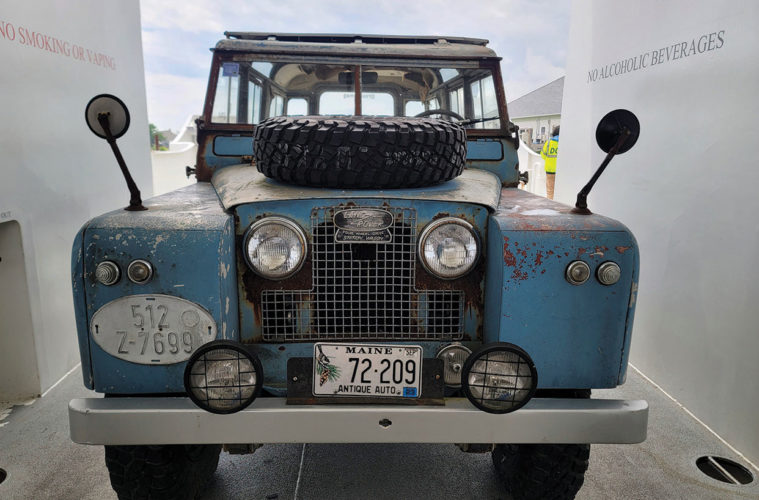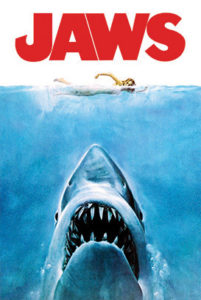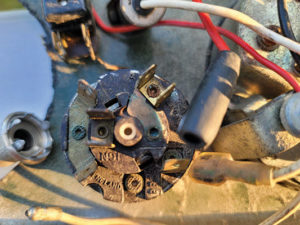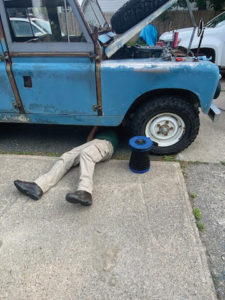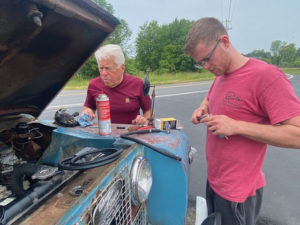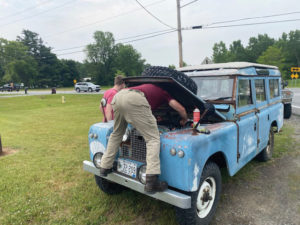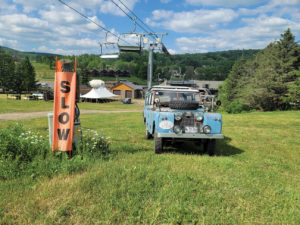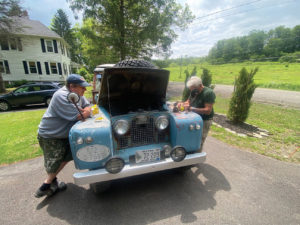As I boarded the ferry to begin my 500-mile drive to the ANARC Diamond Jubilee, a crew member gave my 109” a dubious look. “It’s not going to break down, is it?”
I laughed nervously and assured him, “No, of course not.” I felt guilty.
As the “QE I,” (’66 Series IIA 88” SW) had participated in the ANARC 50th event in 1998, I felt that “Rickman” (’67 Series IIA 109” SW) should do the honors 25 years later. To call my preparations for this trek “minimal” would be generous; I found myself swamped by work with little Land Rover maintenance time.
One week before my scheduled departure to the ANARC Diamond Jubilee, I noted that the alternator light did not illuminate with the key turned to “on.” When fiddling with the connector on the back of the alternator failed to change anything, I realized I had to install a new alternator. Without a lift, it’s a fiddly job requiring near-Olympic level gymnastics from above and underneath; it’s best done in dry weather, of which we had none in June. I also noticed that various lights and wipers would only work sporadically despite tinkering with the two fuses, so I installed a new fuse block. When that failed to produce the desired results, I got out my Power Probe and began to trace the wiring through the bulkhead and behind the facia. Sadly, few wires retained the original color noted in the schematics.
(Memo to Self: Always label each wire on the back of the switch before removing them. If you don’t, you will spend days calling Rovers North, searching online sources, scouring schematics to determine which wire goes to which spade connector. For example, the IGN spade on the back of your Series IIA ignition switch does not mean direct power from the battery but refers instead to features activated when you turn the key to “on.” Should you make that mistake, your coil will heat up like the Fukushima Daiichi nuclear reactor and you will likely damage the points, rotor and carbon tip on your distributor cap. Don’t ask me how I know this, but I can attest that it will cause problems later.)
It took a week, but as the travel day loomed, I finally sorted out the ignition wiring. I had only enough time left for an oil change and a sweep-out of the interior before my departure. In my haste to catch the ferry, I left behind a box of spare parts and fluids: new points, a condenser, rotor and cap, spark plugs, plug wire set, fuses, hypoid oil pump and various fluids. Arriving on the mainland, I purchased cans of PB Blaster, carb cleaner, Rain-X, gear oil, brake cleaner and shop towels. Surely the spare parts, fluids, an 80-pound toolbox and a swept-up interior would serve as a talisman to ward off breakdowns.
Remember the opening soundtrack to “JAWS?” If you’ve not heard it, find it online. The three simple bass notes thrum though your body as the great white shark approaches its prey, a naïve swimmer. Instead of my Pandora playlist of R&B classics, that’s the soundtrack that should have been resonating within me.
As in the movie, my day started off well with a fine 130-mile drive from Maine to Portsmouth, NH. The following morning, I met up with Scott Preston and his son, Harrison. Scott built up his own multi-generational Defender 90, replete with a newly installed 2.8 diesel rebuilt by Charlie Haigh. Harrison refurbished his Range Rover Classic with a 300 Tdi. Both Land Rovers have traveled vast distances, largely without incident. They agreed to let me convoy with them. (Cue the ominous music from “JAWS”.)
In deference to my 109’s 2.25 4-cylinder, we decided to take two-lane roads across southern New Hampshire (Routes 101 and 9) and Vermont (Route 30). Given the fact I have only a 12-gallon gas tank and a non-functioning gas gauge, we had to stop every 100-miles or so for me to fuel up. My tank would take 8–10 gallons with each stop; Scott and Harrison’s required about 2 cups of diesel. The drive proved quite scenic, but with substantial road reconstruction taking place in Vermont, “Rickman” seemingly cut out with every major bump on the road, sometimes requiring coasting to the side of the road – but every time, “Rickman” would restart.
Thus began a multitude of stops in New Hampshire, Vermont and New York to attempt to diagnose the reasons for its problems. With a Series Land Rover, only two systems – fuel and ignition – determine whether the vehicle runs. When either “Rickman” or I decided that progress should be halted – again – to find a solution, Scott and Harrison would prostrate themselves like Tibetan monks atop a mountain temple, chanting, “Diesels don’t have ignition systems.” Sometimes they looked deep in thought, sometimes they napped, but they clung to the ethos of “No Rover left behind.”
One iron test of their dedication came during a repair stop in central New York. We pulled over on the side of a narrow road; on a ridge above us, we could see a hardscrabble house surrounded by a few parts cars and trucks. As Harrison and I leaned over the engine bay, a shadow loomed above us. We looked up and heard a man introduce himself as “Dave, but everyone here calls me ‘Caveman Dave.’” As proof, he showed us the tattoos on each arm that, sure enough, read “Caveman Dave.” From his demeanor, the beer in his right hand was not his first. He claimed expertise on Chevy engines, but not “strange ones like this.” (Harrison said later that he, a professional mechanic, had never worked as quickly in his life.)
At different stops, I took off the distributor cap and discovered its carbon tip no longer looked like a perfect circle, and a black dust covered the rotor’s center rivet. After cleaning them with brake cleaner and an emery cloth, we checked the points gap and found it fine. Over time, we also cleaned out the Weber’s fuel filter, added another inline filter, checked the fuel pump, opened the carburetor top and sprayed carb cleaner into the fuel bowl’s jets and those on the side.
During the Diamond Jubilee itself, “Rickman” ran wonderfully, including tackling the steeps hills on the way to Cortland. It appeared that my travails had ended – not!
I departed on Sunday morning following Scott Preston and within 20 miles, “Rickman” displayed all its running faults again. On State Route 206 outside of Whitney Point, I decided to pull over and investigate the failure to proceed. Having watched my mechanical capabilities too often, Scott settled in for a long summertime nap. Shortly after, Rick Wheeler stepped out of his handsome farmhouse carrying two orange cones, saying “I’ve seen too many accidents here.” (Perhaps my reputation as a mechanic had preceded me?) Intrigued by the two Land Rovers and our description of the Diamond Jubilee, the retired health sciences educator stuck around to watch, offer drinks, even a ride to an auto parts shop for a “universal” coil. (“Universal” did not include Series Land Rovers, evidently, as “Rickman” stopped running within the first 100 yards of the swap out.)
Assessing my skill level, Rick offered to let us park “Rickman” in his driveway if I wished to arrange for a flatbed tow. He also called his brother, Tom, a real mechanic, who drove over in a truck laden with tools and diagnostic equipment. He reviewed the ignition steps I had taken and double-checked them. Finally, Tom went old school. I started the engine and watched Tom pull the throttle linkage to increase the rpms, then place the palm of his hand over the carburetor throat. The rpms decreased dramatically; removing his hand, the rpms shot up again and a plume of black smoke blew out of the exhaust. The engine then idled beautifully; a test drive up a steep hill went successfully. I tried to reward Tom and Rick, but they would not accept any funds for their time and energy. I plied them with copies of Rovers Magazine and extra Diamond Jubilee swag.
(“No Rover Left Behind” also meant that Barry Enis, Kent, CT, David Short, Sterling, VA, and Craig Jones, Clearwater, FL, who took the same route to reach interstate highways, would stop and offer help in diagnosing and trailering.)
By mid-afternoon, my breakdowns had butchered Scott’s travel plans substantially, so we decided to forgo our planned backroads for the interstate highway system. While Scott’s Defender 90, with its 2.8L engine, could cruise at far higher speeds, he gamely reduced his speed to 65 mph, which was “Rickman’s” top end. By the time we hit the Massachusetts Turnpike, I felt comfortable enough about the 109’s reliability to send him on his way. (Yes, I was also within my AAA towing distance.) He scooted ahead toward his overnight destination of Portsmouth, NH, where I later found a motel room. I made it home to the island without further incident – and, of course, “Rickman” has run perfectly since then.
(Memo to Self: Pay attention to the maintenance schedule)
